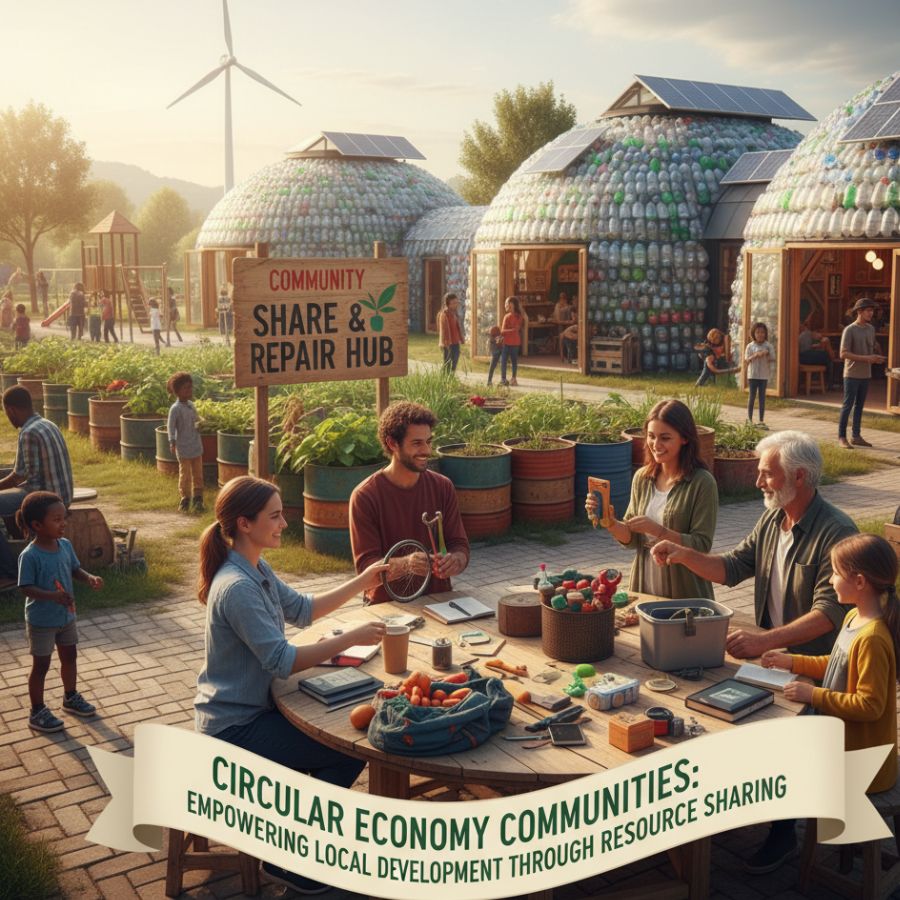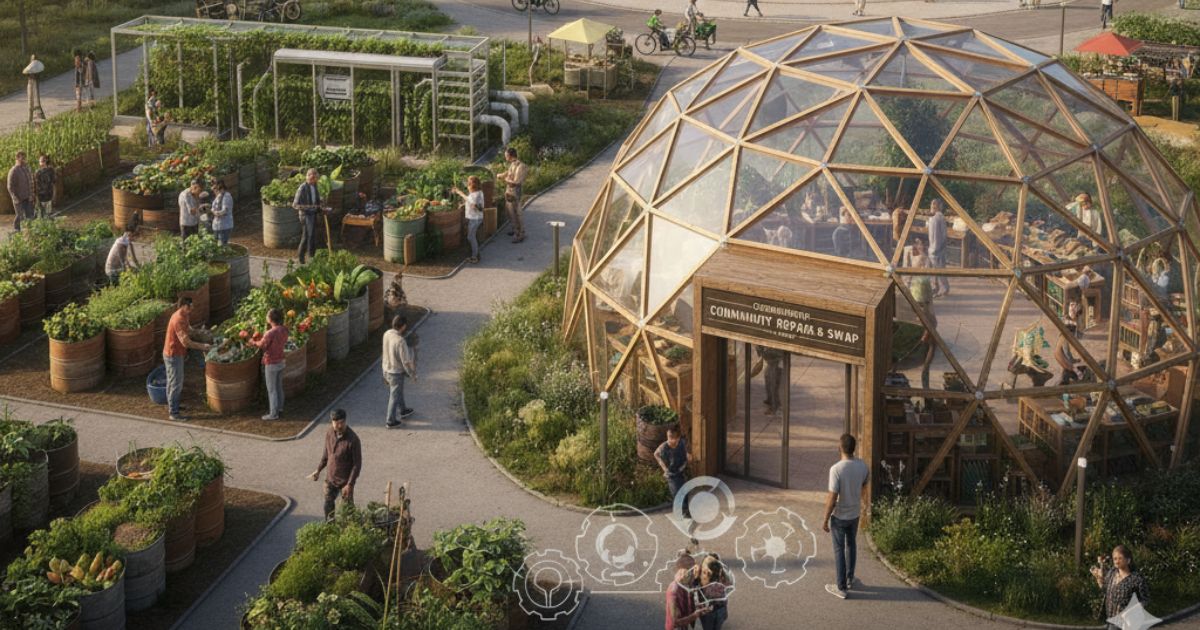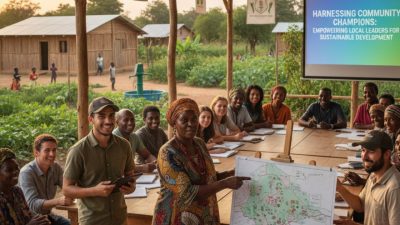Many communities today are turning to the circular economy to reduce waste and protect the environment. Instead of the old method of “take, make, dispose,” the circular model focuses on reuse, repair, recycling, and sharing. It helps people use resources wisely and avoid unnecessary waste.
Local projects like tool libraries, repair cafés, sharing hubs, swap stations, and community fridges make it easy for residents to share items and support each other. These simple ideas help lower consumption, save money, and build stronger social connections. Cities such as Amsterdam, Berlin, and Glasgow are using these community programs to promote sustainable living and support a green local economy.
This blog will show you how to plan and launch your own circular economy project. You will learn clear steps to engage residents, reduce waste, and create long-term community benefits. The goal is to help your neighborhood grow stronger, greener, and more connected through practical circular solutions.
What Is the Circular Economy and Why It Matters
The circular economy is a new way of thinking about production, consumption, and waste. Instead of following the traditional linear model of “take, make, dispose,” the circular model encourages us to reuse, repair, recycle, and regenerate. The idea is to keep materials in use for as long as possible so we waste less and get more value from every product.
In communities, the circular economy becomes practical and visible. It means sharing items instead of buying new ones, repairing broken products instead of throwing them away, and finding creative ways to give old materials a second life. Community-led projects like repair cafés, sharing hubs, tool libraries, community fridges, and upcycling workshops make these ideas easy for everyone to take part in.
These projects help people save money, reduce waste, and use fewer natural resources. They also build local resource loops, meaning a neighborhood can rely less on long supply chains and more on what is already available within the community. This is especially important during economic disruptions or shortages, when access to new products becomes difficult.
The circular economy also provides social and economic benefits. It creates green jobs, supports local artisans and repair experts, and encourages small businesses that focus on reuse and sustainable services. At the same time, it strengthens social bonds because people work together, share tools, exchange knowledge, and support each other.
By adopting circular practices, communities become more resilient, more connected, and more environmentally responsible. It is a practical way for neighborhoods to contribute to climate action, reduce their carbon footprint, and create a healthier and more sustainable future for everyone.
Benefits for Community Development

Circular economy practices bring many valuable benefits to community development. They help reduce household waste and lower municipal disposal costs, which eases pressure on local landfills. These practices also strengthen social connections by encouraging neighbors to share, repair, and reuse items together.
Circular economy projects support local green entrepreneurship. They create opportunities for repair cafés, upcycling workshops, community makerspaces, and tool libraries to grow as small businesses or volunteer programs. This boosts the local economy while promoting sustainable habits.
Circular systems also improve community resilience. When people share resources and maintain local repair skills, communities become less dependent on global supply chains. This helps residents access essential items during economic challenges, emergencies, or supply shortages.
Overall, circular economy initiatives make communities more connected, more resource-efficient, and better prepared for the future.
Key Resource Sharing Models
Communities can bring circular economy ideas to life through several practical sharing models. These models reduce waste, lower costs, and strengthen local connections.
Tool Libraries:
Residents borrow tools such as drills, saws, or gardening equipment for free or with a small membership fee. This reduces the need for every household to buy expensive tools they rarely use.
Repair Cafés:
Skilled volunteers help people fix broken items like electronics, clothing, and bicycles. This extends product life, builds repair skills, and keeps usable items out of landfills.
Community Fridges & Pantries:
Shared fridges or shelves allow neighbors to donate surplus food. Anyone can take what they need. This reduces food waste and supports families facing food insecurity.
Clothing Swaps:
These simple events let people exchange gently used clothing. They promote reuse, cut textile waste, and reduce dependence on fast fashion.
Makerspaces & Upcycling Workshops:
Shared creative spaces provide tools and materials for making new items from discarded materials. People learn DIY skills, create eco-friendly products, and support local circular innovation.
Step-by-Step Guide to Launching a Resource Sharing Initiative
Launching a successful circular economy project requires careful planning and community buy-in. Follow these steps:
- Assess Local Needs and Assets: Conduct surveys or focus groups to identify which resources are in demand and what skills volunteers can offer.
- Form a Steering Group: Recruit local champions, nonprofit partners, business owners, and municipal representatives to guide the project.
- Secure a Location and Funding: Look for donated space, grants, sponsorships, or crowdfunding to cover rent, equipment, and insurance.
- Develop Policies and Procedures: Create membership guidelines, safety protocols, booking systems, and liability waivers.
- Recruit Volunteers and Staff: Train facilitators for repair stations, librarians for tool checkout, and social media managers for promotion.
- Launch a Pilot Program: Start small, gather feedback, and refine processes before scaling up.
- Promote Widely: Use local news outlets, social media, flyers, and word of mouth to attract members and donors.
Case Studies in Circular Community Success
1. Greenfield Tool Library (USA): In a city of 100,000 residents, volunteers converted a vacant storefront into a fully stocked tool library. Within six months, 500 members borrowed over 2,000 tools, saving an estimated $150,000 in retail purchases and reducing community waste by 20 tons of unused equipment.
2. Repair Café Amsterdam (Netherlands): What began as a grassroots meetup evolved into a citywide network hosting weekly repair events. Over three years, volunteers fixed more than 10,000 items, cutting CO2 emissions by 58 metric tons and fostering civic pride and skill development among participants.
Measuring Impact and Success
Tracking performance is crucial for sustainability and funding. Key metrics include:
- Membership Growth: Number of active users and repeat participants.
- Items Reused or Repaired: Total volume or weight of goods diverted from landfill.
- Cost Savings: Estimated dollars saved by members versus retail prices.
- Volunteer Engagement: Hours contributed and retention rates among volunteers.
- Environmental Benefits: Reduced carbon footprint, waste diverted, and resources conserved.
Overcoming Common Challenges

Circular community projects often encounter obstacles such as limited funding, liability concerns, low volunteer engagement, and difficulty maintaining long-term participation. However, these challenges can be overcome with thoughtful planning and strong community partnerships.
One of the most common barriers is financial support. Many circular economy initiatives rely on donations, small budgets, or volunteer labor. To address this, communities can apply for sustainability grants, environmental innovation funds, or local government community development programs. Partnering with nonprofits, universities, and eco-focused organizations can also provide funding, resources, and technical expertise.
Liability and safety concerns are another frequent issue, especially for tool libraries, repair cafés, and public workshops. Collaborating with local governments or established nonprofits can help secure affordable insurance coverage and ensure compliance with safety regulations. Clear guidelines, volunteer training, and proper equipment maintenance further reduce risks.
Low participation is also a major challenge in the early stages. Many residents are unfamiliar with concepts like repair culture or shared asset systems. To increase engagement, organizers can host free introductory events, open houses, and skill-building workshops that demonstrate the value of resource sharing. Hands-on activities—such as beginner repair sessions or craft events—make these projects more approachable and enjoyable.
Visibility is equally important. Sharing early wins on social media, community newsletters, and local events helps build credibility and excitement. Showcasing real stories, such as a successful repair or a family benefiting from a community fridge, encourages others to get involved.
Finally, long-term sustainability depends on broad community involvement. Engaging diverse groups—youth clubs, senior communities, schools, local businesses, and neighborhood associations—creates a strong support network. When many different people feel ownership of the project, it becomes more resilient and continues to grow even as volunteers rotate or participation fluctuates.
By addressing these challenges with proactive solutions, circular community projects can thrive and deliver lasting social, environmental, and economic benefits.
Future Outlook: Scaling and Replication
Circular economy projects will continue to grow as more people understand their benefits. Resource-sharing hubs, repair networks, and tool libraries are likely to spread across cities and regions. Digital platforms will make it easier for communities to exchange ideas, share equipment, and learn from each other. Technologies such as real-time tracking and blockchain can improve transparency, build trust, and help manage shared assets more efficiently.
As these systems expand, circular economy practices will reshape local economies, cut waste, and reduce pressure on the environment. Most importantly, widespread adoption will strengthen community bonds and support more resilient, connected neighborhoods.
Conclusion
Building circular economy communities through resource sharing is a transformative approach to sustainable development and community building. When residents use tool libraries, repair cafés, community fridges, and upcycling workshops, they reduce waste, save money, and build trust with their neighbors. These shared spaces help people learn new skills, reuse materials, and support a greener lifestyle.
Success requires careful planning, inclusive leadership, and regular impact tracking. Even small projects—like a neighborhood repair event or a shared pantry—can grow into larger circular initiatives. By starting small and involving the community, any neighborhood can become a model for circular economy innovation. Together, shared resources and collaboration can create a more resilient, regenerative, and connected future.
FAQs
What is a circular economy in simple terms?
A circular economy is a sustainable model that focuses on reusing, repairing, and recycling materials instead of discarding them. It reduces waste, conserves resources, and promotes long-term environmental and economic resilience within communities.
How can communities benefit from circular economy practices?
Communities adopting circular economy principles can reduce waste management costs, create green jobs, and strengthen social ties. Initiatives like tool libraries, repair cafés, and community fridges encourage collaboration and local self-sufficiency.
What are some examples of circular economy projects?
Common circular economy projects include tool-sharing libraries, repair cafés, upcycling workshops, community fridges, and clothing swaps. These models help minimize waste while empowering residents to share skills and resources.
How do I start a circular economy initiative in my community?
Begin by assessing local needs and available assets. Form a steering group, secure funding or space, and launch a small pilot project. Promote it through social media, local events, and partnerships to build awareness and engagement.
Why is the circular economy essential for sustainable development?
The circular economy supports sustainable development by reducing environmental impact, conserving resources, and building economic resilience. It transforms consumption habits, encourages innovation, and strengthens community collaboration for a greener future.





